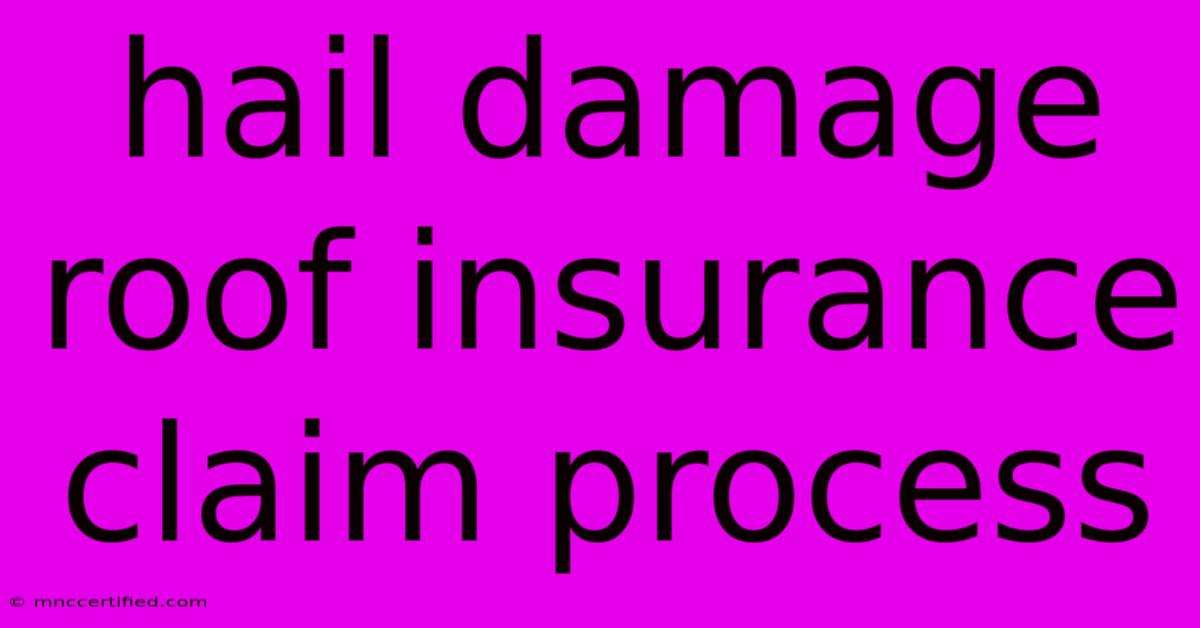Hail Damage Roof Insurance Claim Process

Table of Contents
Navigating the Hail Damage Roof Insurance Claim Process: A Step-by-Step Guide
A hailstorm can leave your roof battered and bruised, causing significant damage and raising the question: how do you file an insurance claim? Navigating the insurance claim process can feel overwhelming, but understanding the steps involved empowers you to handle the situation effectively. This guide breaks down the process of filing a hail damage roof insurance claim, ensuring you're prepared to protect your property and financial interests.
Step 1: Document the Damage
The first step is crucial: document the damage thoroughly. Take detailed photos and videos of your roof from various angles, focusing on:
- Damaged shingles: Capture close-ups of any broken, cracked, or missing shingles.
- Dents and punctures: Document any dents, punctures, or other signs of impact on the roof surface.
- Gutters and downspouts: Check for damage to gutters and downspouts caused by falling hail.
- Overall roof condition: Capture the roof from a distance to show the extent of the damage.
It's also important to note the date and time of the hailstorm, as well as the severity of the weather.
Step 2: Contact Your Insurance Company
Immediately contact your insurance company to report the damage. Inform them of the hailstorm, the date and time it occurred, and the extent of the damage you observed.
Keep these points in mind:
- Review your policy: Before contacting your insurance company, thoroughly review your policy to understand your coverage limits, deductible, and any specific requirements for filing a claim.
- Be clear and concise: When speaking with your insurer, provide accurate and detailed information about the damage.
- Document everything: Keep records of all communication with your insurer, including dates, times, and any correspondence.
Step 3: Scheduling an Inspection
Your insurance company will likely schedule an inspection with a qualified roof inspector to assess the damage.
- Allow access: Make sure the inspector has easy access to your roof.
- Be present: If possible, be present during the inspection to answer any questions the inspector might have.
- Review the report: Once the inspection is complete, review the report carefully. Ensure it accurately reflects the damage and the extent of repairs needed.
Step 4: Negotiating Your Claim
The inspector's report will be used to determine the scope of the repairs and estimate the cost.
- Negotiate fairly: Be prepared to negotiate with your insurance company about the repair costs. If you disagree with their assessment, provide supporting documentation, such as quotes from other contractors.
- Understand your deductible: Remember to factor in your deductible when considering the settlement amount.
Step 5: Choosing a Contractor
After your claim is approved, you'll need to choose a qualified roofer to perform the repairs.
- Get multiple quotes: Obtain quotes from several reputable roofing contractors in your area.
- Verify credentials: Ensure the contractors are licensed, insured, and experienced in roof repair.
- Read reviews: Check online reviews and testimonials from previous clients.
- Review contracts carefully: Read through the contract thoroughly before signing it. Understand the payment terms, warranties, and any other details.
Step 6: Completing the Repairs
Once you've chosen a contractor, schedule the repairs.
- Communicate clearly: Maintain open communication with your contractor throughout the repair process.
- Inspect the work: Carefully inspect the completed repairs to ensure they are satisfactory.
- File a final claim: Once the repairs are completed, file a final claim with your insurance company to receive the remaining settlement amount.
Additional Tips for a Smooth Claim Process
- Keep all documentation: Maintain a file with all documentation related to your claim, including photos, videos, inspection reports, and correspondence with your insurance company.
- Be proactive: Don't wait for your insurance company to contact you. Proactively contact them to keep the process moving forward.
- Be patient: The claim process can take time. Be patient and maintain open communication with your insurance company and contractor.
Hail Damage Roof Insurance Claim Process FAQs
Q: What if my insurance company denies my claim? A: If your claim is denied, you have the right to appeal the decision. Consult with your insurance policy and consider seeking legal advice.
Q: What if my insurance company offers a settlement that is too low? A: You have the right to negotiate the settlement amount. Provide documentation to support your claim and be prepared to discuss the matter with your insurance company.
Q: Can I choose my own roofer? A: Check your policy to see if you have the right to choose your own contractor. Some policies may require you to use an insurer-approved contractor.
Q: What if the damage isn't immediately apparent? A: It's possible for hail damage to be hidden beneath the shingles. If you suspect damage, have a professional inspection performed even if the damage isn't readily visible.
Q: How long do I have to file a claim? A: Your insurance policy will specify the time limit for filing a claim. Don't wait too long; it's best to file as soon as possible after the damage occurs.
Conclusion
Filing a hail damage roof insurance claim can be a complex process, but understanding the steps involved empowers you to protect your property and financial interests. By following this guide, you can navigate the claim process confidently and ensure your roof is repaired promptly and effectively.

Thank you for visiting our website wich cover about Hail Damage Roof Insurance Claim Process. We hope the information provided has been useful to you. Feel free to contact us if you have any questions or need further assistance. See you next time and dont miss to bookmark.
Featured Posts
-
Fed Rate Cut Expected Former Vice Chair
Nov 08, 2024
-
Football Fans Attacked Israel Sends Rescue Planes
Nov 08, 2024
-
Argentine Prosecutors Charge Trio In Singer Death
Nov 08, 2024
-
Penalty For Not Giving Insurance Details
Nov 08, 2024
-
Stephen A Smith Distances From Kimmel
Nov 08, 2024